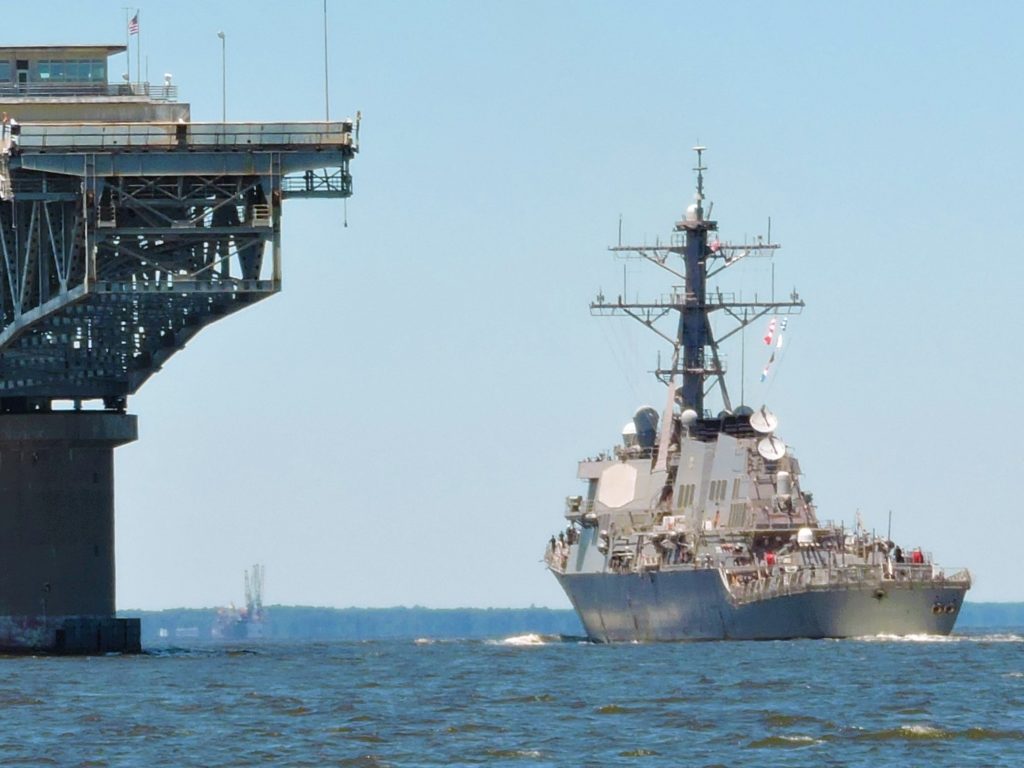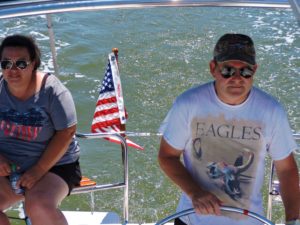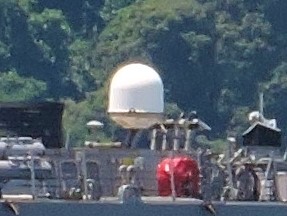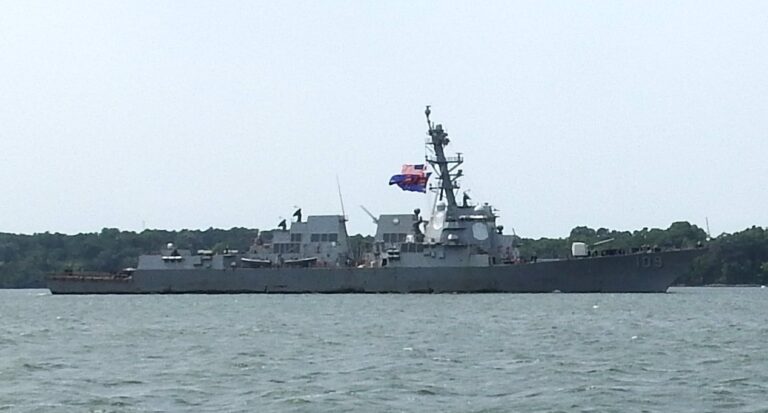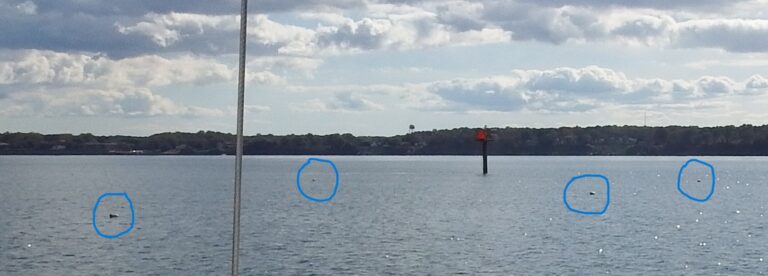People ask, “What’s it like to sail the high seas?” Two independent couples from New York and Virginia went sailing on the high seas of the York River as fresh easterly breezes provided a speedy route down river. In recent days the winds have been strong after a front blew through. By now they have calmed to 10-15 mph, ideal for sailing a mid-size boat like Let’s Go Sail. They got to see a US Navy warship under way before it heads for the high seas of the Atlantic on the way to the Med.
 Jun Li brought Ying Zou in from Centerville in Northern Virginia. She was apprehensive at first about sailing, but she got the gist of it quickly behind the wheel. Ying tacked multiple times down river on a close reach before turning to try a beam reach.
Jun Li brought Ying Zou in from Centerville in Northern Virginia. She was apprehensive at first about sailing, but she got the gist of it quickly behind the wheel. Ying tacked multiple times down river on a close reach before turning to try a beam reach.
Eventually two big Moran tugs chugged past on their way to Yorktown Naval Weapons Station. I radioed one of them to indicate we would sail on the north side of the river to give them plenty of leeway. A half hour later while tacking on the south side of the York we spotted the object of the tugs’ exercise. It was the Navy warship USS Stout, a guided missile cruiser and frequent client of the Weapons Station. I radioed the bridge to indicate I would stand fast on the south shore to let the ship pass without getting in its way. The radio operator thanked me. The Stout looked like it was bearing down straight for us, but then it turned to starboard to go up the middle of the river.
By now the Coleman Bridge warning bells had gone off, stopping traffic as the two giant spans began to turn. My crew was astonished at the scene because it is simply breathtaking up close.
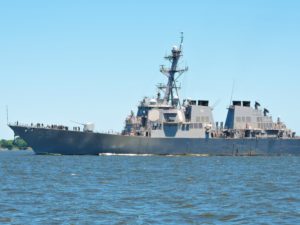 Jun said, “That’s warship 55. Back in 2014 we got to go on warship 51 at the Norfolk Naval Base. It was the Fourth of July and we just happened to be there, so we took advantage of the open house for the holiday.” I pointed out where the missiles eject from, between two large tent-like structures. “Exactly. They showed us that and told us that their missiles were calibrated to precise targets in China. That discouraged me, since China is my home country.”
Jun said, “That’s warship 55. Back in 2014 we got to go on warship 51 at the Norfolk Naval Base. It was the Fourth of July and we just happened to be there, so we took advantage of the open house for the holiday.” I pointed out where the missiles eject from, between two large tent-like structures. “Exactly. They showed us that and told us that their missiles were calibrated to precise targets in China. That discouraged me, since China is my home country.”
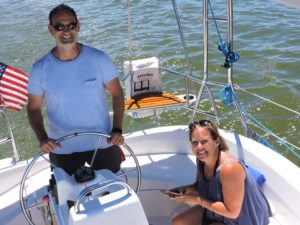 Laura and Dan Spanbauer were vacationing in Williamsburg from their home in Schenectady. They used to boat in the Thousand Lakes section of upstate New York. “We had a 23-foot motorboat, but over the years the kids all but wrecked it,” Dan said. Laura added, “We used to take people to one of the lakes that bordered Canada. We’d say, ‘Now lean overboard and look for the red line that separates the US from Canada. They would look and peer in wonderment but never saw it.”
Laura and Dan Spanbauer were vacationing in Williamsburg from their home in Schenectady. They used to boat in the Thousand Lakes section of upstate New York. “We had a 23-foot motorboat, but over the years the kids all but wrecked it,” Dan said. Laura added, “We used to take people to one of the lakes that bordered Canada. We’d say, ‘Now lean overboard and look for the red line that separates the US from Canada. They would look and peer in wonderment but never saw it.”
Sailing on Submarines
The next morning yielded a glassy York River for the first time in weeks. That led to motoring about to present the history of the Battle of the Capes and Siege of Yorktown to the Mathias family of Monrovia MD. We somehow got to talking about submarines, which led Mark Mathias to relate some fascinating information.
“I worked nine years on subs, not in the Navy but as a private contractor. We went to sea test all kinds of conditions for underwater acoustics. Once we were on the Baton Rouge sneaking around in the Black Sea, when all of a sudden we felt this Bam! Bam! from below. It was a Russian sub trying to surface beneath us. I don’t think they knew we were there, it was just a coincidence. They damaged their boat worse than ours. We were able to get back to Norfolk sub-surface for repairs.”
I asked him about the Scorpion since this is the 50th anniversary of the downing. “They say it accidentally shot off a torpedo that circled around and hit the sub, but I doubt that. I’ve seen photos and there is definitely a big hole in the side. I don’t think it was their own torpedo.” Investigations have asserted that the Russians did it and we covered it up to avoid World War III.
Underwater acoustics offers practical applications besides military. “My ex-wife’s father was a big sailor and he was planning to sail to Cuba, including during the night. He was scared that a Russian sub might surface on him, so I told him to simply play the radio. They’ll hear that, believe me. We can pick up that sound very easily.”
We motored under the Coleman Bridge to see the USS Stout in dock. Lisa was familiar with the Phalanx defense system on the aft. “I used to work with Raytheon and we covered that,” she said. Mark explained that beneath an innocent looking radar dome is a Gatling gun. “It’s got five barrels that can shoot thousands of 20 millimeter rounds at any incoming aggressor.”
 The winds picked up in the afternoon when the Thompson family came to sail. Lorri Thompson of Houston brought her four teenage boys to learn how to sail. In rising winds of 5-10 mph they went through the Close Reach for numerous tacks. Then we sailed downwind on a Broad Reach by flying the spinnaker. It required an able-bodied crew and they proved excellent. The boys proved very competitive, but Mom won the day on speed with a 12.5 mph mark. They were all proud of her.
The winds picked up in the afternoon when the Thompson family came to sail. Lorri Thompson of Houston brought her four teenage boys to learn how to sail. In rising winds of 5-10 mph they went through the Close Reach for numerous tacks. Then we sailed downwind on a Broad Reach by flying the spinnaker. It required an able-bodied crew and they proved excellent. The boys proved very competitive, but Mom won the day on speed with a 12.5 mph mark. They were all proud of her.
The family was on an extended vacation tied to lacrosse tournaments on the East Coast. They crammed a week’s worth of sightseeing into a few days in New York. Lorrie said, “We did the Statue of Liberty, Chinatown, Rockefeller Center, Times Square, Central Park and Coney Island. We saw a Yankees game and took trapeze lessons on the top of a building at Pier 40.” From there they went to Washington and got to observe a Senate session from the gallery.
“I told them than today is a chill-out day to just enjoy sailing. Tonight we head to Skyline Drive to camp out and hike.” I was exhausted.
Dodging Raindrops
Next day, Michele and Mike Kennedy took their three boys sailing on day that became increasing cloudy with shifty winds. Within an hour we were positioning to avoid one storm moving on land past Yorktown, and later returned to Yorktown to avoid a storm on the Gloucester side. No one seemed to mind. “I love the sound of rolling thunder,” Michele said.
 Mike served in the Army’s 5th Special Forces as a unit commander in Iraq. We talked about the difference between the Army of the Vietnam era and today. “We depend on cohesion of force,” he said thoughtfully. “My unit used to be 12 men, but we had so many problems with retention that I got it down to eight. We were together training for nine months before deployment.”
Mike served in the Army’s 5th Special Forces as a unit commander in Iraq. We talked about the difference between the Army of the Vietnam era and today. “We depend on cohesion of force,” he said thoughtfully. “My unit used to be 12 men, but we had so many problems with retention that I got it down to eight. We were together training for nine months before deployment.”
How did that go? “We didn’t lose anyone. A few got hurt, but their hospitalization didn’t take them home. I got them all out.” I was curious about the flawed intelligence we had in Vietnam to today’s. “We operated on our own intelligence or intelligence produced by others, but we didn’t always act on it. We probably had 400 times over the course where we didn’t take action because the intel didn’t look right or feel right in the gut.”
Our 16th PID unit at Long Binh vowed never to hold a reunion. “We keep up with each other on our Facebook page, We’re close.” Soon the skies darkened for a larger storm, so we headed in to beat it.
Fact-Finding Sailing on the High Seas
Some people choose to remain silent and serene while sailing. Others like to chat. Some convey reams of data and info that are fascinating. Consider Mike Lizbinksi of Sugarloaf PA, who took his family sailing while on vacation in Williamsburg.
 “I served on the USS Theodore Roosevelt, one of the first nuclear aircraft carriers built in the Nineties. It was so big and steady that in storms with 25-foot seas the boat would hit five or seven inches of heeling. It might knock over the chili bar, nothing more. You could look down a long hallway and see the frame of the boat twisting in the storm because it was built to do that. We didn’t have video phones in those days to record it. The ship would plow through the waves at 30 mph. Yet as big as it was, today’s mega-cruisers displace twice that of an aircraft carrier, 500,000 tons. We deployed the entire carrier group on short notice for the Persian Gulf War in 1991. Grabbed up every supply that we could fine on shore in stores and supermarkets. Never had so much king crab in my life. We rounded the Horn and got to the Suez canal, and left the group behind us as we went to war.”
“I served on the USS Theodore Roosevelt, one of the first nuclear aircraft carriers built in the Nineties. It was so big and steady that in storms with 25-foot seas the boat would hit five or seven inches of heeling. It might knock over the chili bar, nothing more. You could look down a long hallway and see the frame of the boat twisting in the storm because it was built to do that. We didn’t have video phones in those days to record it. The ship would plow through the waves at 30 mph. Yet as big as it was, today’s mega-cruisers displace twice that of an aircraft carrier, 500,000 tons. We deployed the entire carrier group on short notice for the Persian Gulf War in 1991. Grabbed up every supply that we could fine on shore in stores and supermarkets. Never had so much king crab in my life. We rounded the Horn and got to the Suez canal, and left the group behind us as we went to war.”
To see an aircraft carrier make a quick turn and take off, check out the video below.
 The Lizbinkis live in rural Pennsylvania. “We don’t see many deer but we see bears. I have one of those bear-proof trash cans in which you have to screw this big yellow top on to prevent the bear from getting accent. One time he just took it away into the woods and bit the can enough times to get to the food. Then they go after our bird feeders. I’m out there rummaging in the woods looking for bird feeders and oblivious that I might encounter a bear.”
The Lizbinkis live in rural Pennsylvania. “We don’t see many deer but we see bears. I have one of those bear-proof trash cans in which you have to screw this big yellow top on to prevent the bear from getting accent. One time he just took it away into the woods and bit the can enough times to get to the food. Then they go after our bird feeders. I’m out there rummaging in the woods looking for bird feeders and oblivious that I might encounter a bear.”
Let’s Go Sailing on the High Seas
Scroll down Rates and pick a day for a sailboat charter. Scroll down Reviews on Trip Advisor. Go back to the Home Page of Williamsburg Charter Sails.
sailing on the high seas sailing on the high seas sailing on the high seas sailing on the high seas

